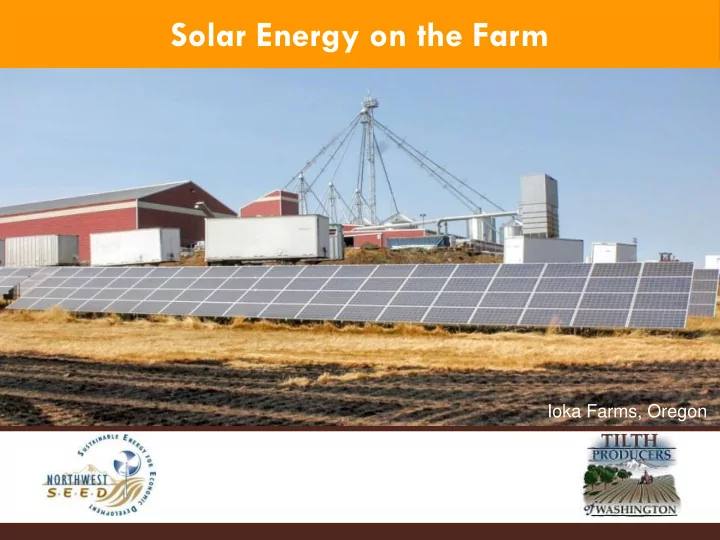

Solar Energy on the Farm Ioka Farms, Oregon
About Northwest SEED Technical Assistance Education Policy Advocacy Practical Implementation
Outline Solar technology Solar economics Lunch Solar tour General tour
Rents Due Ranch Photo Credit: PCC Natural Markets Photo Credit: Fire Mountain Solar
Climate Change Impacts Increased winter precipitation, flooding, soil erosion Longer dry season, drought stress Warmer temperatures, heat stress Lack of cooling days for fruit crops, early budding Increased pests, weeds, and diseases Increased forest fires, worsened air quality Winter Spring Summer Fall
Climate Change Adaptation Adjust timing of planting Modify crop varieties Diversify crops grown Transition to new crops Efficient irrigation techniques Source: “The Washington Climate Change Impacts Assessment: Evaluating Washington’s Future in a Changing Climate.” The Climate Impacts Group, University of Washington, June 2009.
Climate Change Mitigation Reduce tillage Improve nitrogen fertilization efficiency Capture methane emissions from manure Decrease energy consumption Increase renewable energy generation Source: “Northwest Climate Assessment Report: Implications for Our Landscapes, Waters, and Communities.” Island Press, 2013 . http://cses.washington.edu/db/pdf/daltonetal678.pdf
Benefits of Renewable Energy No air or water pollution No water consumption Efficient transmission Energy independence Reduced/stable utility bills Diversify farm revenue Marketing opportunities Supports local economy
Solar Hot Water Solar Hot Air Solar Photovoltaics (PV) Micro Hydro Wind Energy Methane Digesters
Solar is part of your energy solution
Energy Audit Resources WSU Energy Office Karen Messmer, Farm Energy Program messmerk@energy.wsu.edu 360-956-2090 NRCS Mt Vernon Service Center 2021 E. College Way, Suite 214 360-428-7684 Puget Sound Energy http://pse.com/savingsandenergycenter SnoPUD http://www.snopud.com/conservation.ash x?p=1100
Does solar work in Washington?
Fire Mountain Solar LLC Designed & installed on-grid, off-grid and grid-tied battery- backup systems throughout WA since 2001. Assisted 5 businesses with USDA grants in 2015-2016 LOCAL: Rents Due Ranch, Camano Coffee Roasters, Orchards Nursery, Skagit Valley Food Co-op, Monroe Business Services installed 22KW USDA grant project in Sunnyside (solar electricity to run irrigation pumps). Designs solar, helps with USDA application, handles all utility and incentive paperwork, helps afterward to get you your incentive earnings. Family-owned business located outside Mt Vernon. Contact: Joan Schrammeck, Joan@FMSolar.com, 360-422-5610
Solar Terminology Photovoltaic (PV) = Solar Electricity Watt (W) = instantaneous measure of power Like your speedometer Kilowatt (kW) = 1000 W Kilowatt-hour (kWh) = amount of energy produced Like your odometer 1 kW used or produced for 1 hour = 1 kWh
Solar Fun Facts Average U.S. home uses about 12,000 kWh/year 1 kW of PV produces about: 1,000 kWh/year in Seattle 1,300 kWh/year in Yakima 1300 kWhrs 1000 kWhrs
Typical grid-connected PV System
Typical grid-connected PV System
Do you have the right site? Roof in good condition = Good! Facing South, East, or West = Good!
Do you have the right site? Lots of shade = Not Good Future shade = Not Good
No viable roof space? That’s ok! Pole-mounted Ground-mounted Greenbank Farm, Whidbey Island, Pinehold Gardens, Wisconsin Washington
No viable roof space? That’s ok! Picnic Shelters Awning Jefferson Park, Seattle, WA Bellingham (source: Seattle City Light)
What size system do I need? It depends … Budget Roof shading / orientation Roof space Electric bill offset
How much does it cost? Solar data source: LBNL “Tracking the Sun VII”, systems up to 10 kW in size.
Example installed costs – 10 kW Made in WA Made in OR $40,000 $30,000 ($4.00/W) ($3.00/W) Note: The costs shown are approximate; actual costs for your situation will depend on a number of factors and will be determined after a site visit.
Cost Variables Electric service System size Multiple arrays Type of solar module If roof-mounted: Roof slope and height Type of roof shingles Structural issues
Additional Cost Options Micro inverters Monitoring system Maintenance contract Extended equipment warranties Length of workmanship warranty
Solar PV Incentives No sales tax on systems up to 10kW Solar Federal Tax Credit = 30% of project cost Washington Solar Production Incentive Up to $0.15/kWh for out of state panels/inverters Up to $0.54/kWh for Washington panels/inverters Net Metering – avoided purchase of power MACRS (accelerated depreciation for businesses) SnoPUD Solar Express (up to $8,000)
USDA Rural Energy for America Program Funding available for clean energy projects Grant = 25% Loan Guarantee = 75% Feasibility study grant = 25% Who Qualifies? Rural small businesses Agricultural producers Contact: Brandon Hoffman, 360.428.4322 x161 Brandon.Hoffman@wa.usda.gov
The bottom line FEDERAL TAX CREDIT (30%) + USDA REAP Grant (25%) 65-75% + = OFF WA SOLAR INCENTIVE (5-10%) after year one + MACRS Depreciation (5-6%) + NET METERING (2-3%)
Payback Example – 10 kW System
Payback Example – 10 kW System
Payback Example – 10 kW System
Payback Example - Assumptions 10 kW system Installed cost = $4.00/Watt for Itek, $3.00/Watt for SolarWorld 10,000 kWh/year production (south-facing roof, no shade) Installed by Dec 31, 2016 0.5% annual degradation in output Inverter replacement cost of $1,000 in Year 15 $0.09/kWh utility rate with 3% annual escalation Owner is eligible for 30% tax credit and MACRS depreciation Owner’s federal tax bracket rate is 34% $0.40/kWh in-state and $0.12/kWh out-of-state incentive, reduced 25% annually. Owner receives USDA REAP grant reimbursement of 25%
Generations Credit Union - Since 1939 Home of the Solar Cash Flow™ Loan Own your Solar system for about the monthly cost of your monthly energy bill Low interest Energy Loans-Rates as low as 3.99% Additional items can be financed (HVAC/Roof/Electrical) No loan origination or prepayment fees Fast Loan Decisions, apply online 24/7 Secured by Solar equipment-no home equity needed Friendly service and personalized decisions Kaylyn Milligan-Solar Loan Consultant kaylyn@generationscreditunion.com 425-330-9650
Next steps to go solar • Contact contractors for bids 1 1 2 3 • Receive your site assessments 2 • Compare bids and choose 3 • Apply for grants and financing 4 6 5 4 • Get Solar! 5
Questions?
Solar Tour!
Recommend
More recommend